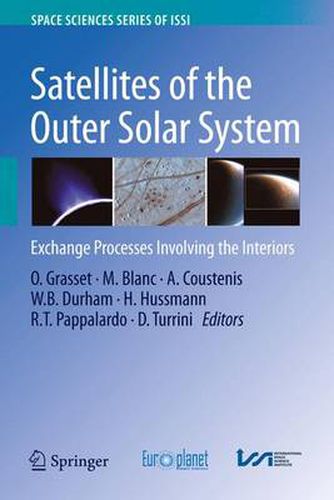Readings Newsletter
Become a Readings Member to make your shopping experience even easier.
Sign in or sign up for free!
You’re not far away from qualifying for FREE standard shipping within Australia
You’ve qualified for FREE standard shipping within Australia
The cart is loading…






This title is printed to order. This book may have been self-published. If so, we cannot guarantee the quality of the content. In the main most books will have gone through the editing process however some may not. We therefore suggest that you be aware of this before ordering this book. If in doubt check either the author or publisher’s details as we are unable to accept any returns unless they are faulty. Please contact us if you have any questions.
Recent space missions to the outer solar system, Galileo (1996-2003) and Cassini-Huygens (2004-today), together with ground observations, have revealed that the moons of the outer solar system are enigmatic objects, introducing extraordinary challenges for geologists, astrobiologists, organic chemists, and planetologists. Chemical exchange exists through the different layers that form their interiors, and also from the interior to the surface. The most convincing evidence is certainly the discovery of water vapour and ice particles emerging from Enceladus’s active south polar region. Evidence for exchange with a subsurface liquid ocean has also been provided by the inference of hydrated salts on the surfaces of Jupiter’s moons, Europa and Ganymede, as well as the detection of sodium salts in particles originating in Enceladus’s plumes. Aqueous exchange with the rocky core may also be possible, considering that 40Ar has been observed in the plumes of Enceladus during one flyby of Cassini and in the atmosphere of Titan. The ongoing CH4 replenishment in Titan’s atmosphere is additional striking evidence of exchange processes within the moons.
$9.00 standard shipping within Australia
FREE standard shipping within Australia for orders over $100.00
Express & International shipping calculated at checkout
This title is printed to order. This book may have been self-published. If so, we cannot guarantee the quality of the content. In the main most books will have gone through the editing process however some may not. We therefore suggest that you be aware of this before ordering this book. If in doubt check either the author or publisher’s details as we are unable to accept any returns unless they are faulty. Please contact us if you have any questions.
Recent space missions to the outer solar system, Galileo (1996-2003) and Cassini-Huygens (2004-today), together with ground observations, have revealed that the moons of the outer solar system are enigmatic objects, introducing extraordinary challenges for geologists, astrobiologists, organic chemists, and planetologists. Chemical exchange exists through the different layers that form their interiors, and also from the interior to the surface. The most convincing evidence is certainly the discovery of water vapour and ice particles emerging from Enceladus’s active south polar region. Evidence for exchange with a subsurface liquid ocean has also been provided by the inference of hydrated salts on the surfaces of Jupiter’s moons, Europa and Ganymede, as well as the detection of sodium salts in particles originating in Enceladus’s plumes. Aqueous exchange with the rocky core may also be possible, considering that 40Ar has been observed in the plumes of Enceladus during one flyby of Cassini and in the atmosphere of Titan. The ongoing CH4 replenishment in Titan’s atmosphere is additional striking evidence of exchange processes within the moons.